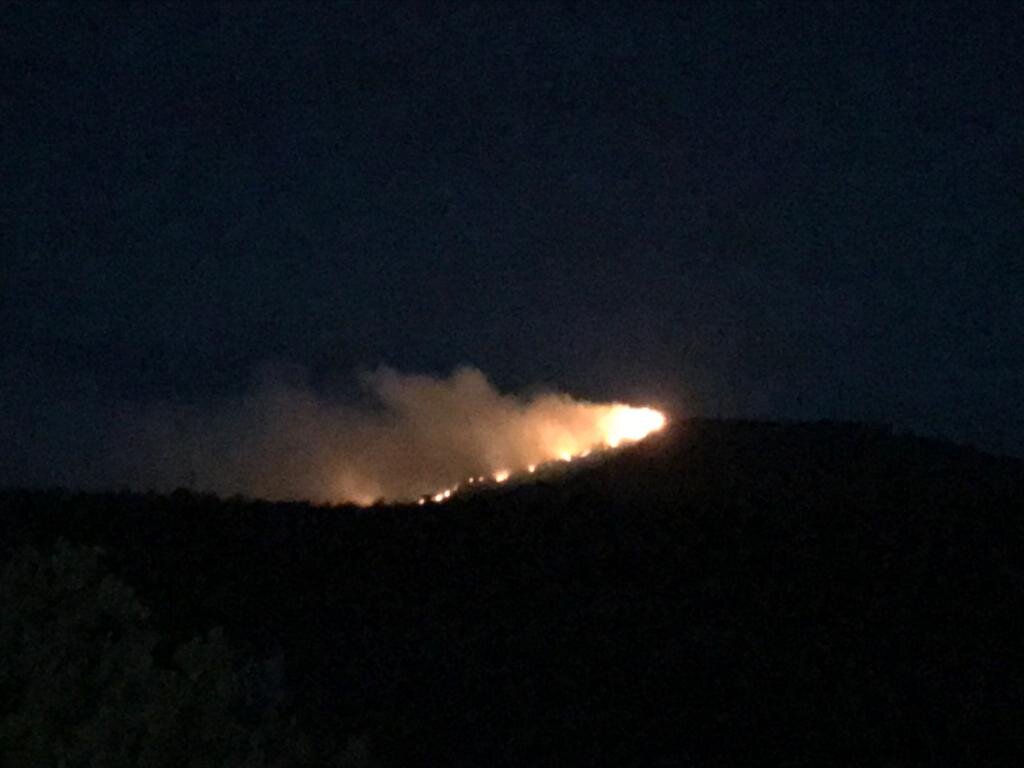Fires on the Lolldaiga Hills
In late March, just when the conservancy was looking its driest, a fire broke out on the western side and blazed for nearly three days and all but destroyed 8,000 acres.
Early pictures of the fire as the smoke got thick and black over the western side of Lolldaiga Hills
By the end of the dry season (typically end of March/beginning of April) the long grass in the area is dry and yellow. As well as this, the seasonal wind is strong and changes direction quickly. Because of this, a rouge spark that came off a British Army cooker found the perfect location to start a fire that quickly became uncontrollable.
While the fire started in the west, it quickly spread into the valleys close to where the training was taking place. Because of Lolldiaga’s hilly topography, fire trucks and firefighters found it very hard to reach the areas where the fire was burning. Teams from The Safari Series, Lolldaiga Hills management and farm workers, neighbouring conservancies and farms, BATUK battalions, sky teams in the form of helicopters and crop spraying planes and local volunteers all worked to stop the fire over the three days. Strategies to put out the fire included water dumps using the helicopters, beating the fire out using bundles of sticks and backburning areas to make fire breaks.
An example of backburning in order to stop the fire spreading further
The Safari Series team, led by Ed, brought the water bowser from the camp and helped fill other spraying devices. Other members of the camp used branches to beat out the fire and stop it from spreading. Much of the time was spent, too, working to backburn areas where it looked likely the fire would spread to. By burning grass and trees, it meant that the fire had nothing to burn when it reached there and so would eventually die down and go out. It is a risky tactic that has good results.
There was a tense afternoon as the wind changed direction suddenly and the fires started spreading towards the camp. For a whole night, the hills opposite were red with burning trees. Thanks to backburning teams and numerous water drops from the crop sprayer and helis, the fire was slowed and eventually died out when the wind changed direction again. We are so grateful for their work in protecting the camp in this scary moment.
The sudden change of wind direction meant that the fire moved south and over the hill that the camp looks over. A very scary night as the flames looked even bigger and more ferocious in the dark!
By the end of the third day, the fire was dying out. Helicopters continued late into the evening to drop water on any small areas of smoke that looked like fire was still burning. Unfortunately, the fire won’t really be fully out until a proper rain arrives - we hope any day now (nearly 10 days after the last day of fire)…
Four days later, once everyone had gone home and the final plumes of smoke had disappeared, Ed and I went for a drive through the heart of the fire location. It was unbelievable to see - huge new roads had been created by the Army’s road grader to be used for their water trucks (great for the future - lots of new areas of Lolldaiga are now accessible for the first time in decades!), swathes of land that was charred black by backburning and, of course, the still-smoking trees whose roots had turned to charcoal under the ground due to intense heat. We saw a number of animals walking carefully through the charred earth, picking their route wisely as to not burn their feet.
The scale of the fire - this valley leads up to the Cedar Forest and burned quickly and intensely
But, on closer inspection, the smaller trees and saplings which look burnt to a crisp from first sight had green and living branches if you scratched away the outer black casing. The ancient cedar forest, which Lolldaiga Hills is famous for, also survived mostly intact. Whilst the cedar trees sustained some damage, they will regrow once the rains come again. It was only the olive trees that were hit the hardest - their dry and old wood was perfect for the fire and they burned extremely hot, some even exploding.
Under the burnt outer layer, the trees are still green - a sign of life and hope for their survival
Fires have been happening across African landscapes since the beginning of time. Unlike news reports, no elephants died in the fire. This is likely because animals have an innate sense of what to do during these situations and escape quickly even hours before the fire gets close to them. It is usually smaller creatures like tortoises that do not survive; this is a great loss as tortoises are prevalent on Lolldaiga and we often have guests seeing them during a game drive.
An example of where backburning worked - the black char on the left is from petrol-burnt grass and then on the right is a large Army-created road to prevent the fire from spreading over. Unfortunately, just outside of the photo is a segment where the fire jumped and burnt almost a football-sized pitch worth of grass in around 10-15 seconds before it was hosed out with water.
Now we all need is for the rains to come - new shoots of grass will regrow quickly, trees will recover and animals will come back to the western valleys again. The rains are becoming late now - and the lives of many, not just the animals and trees of Lolldaiga Hills, rely on arrival of the long rains.






